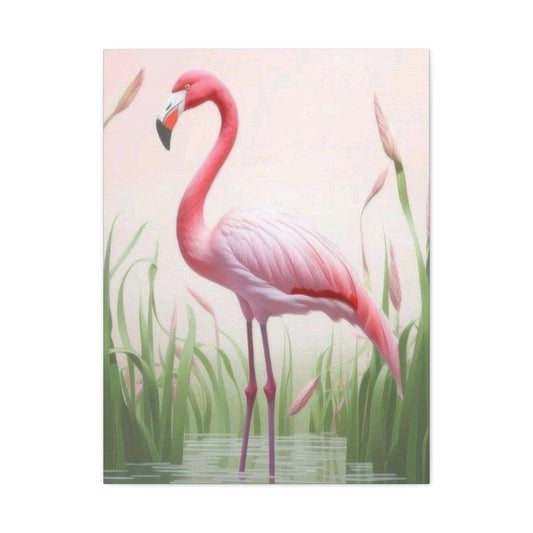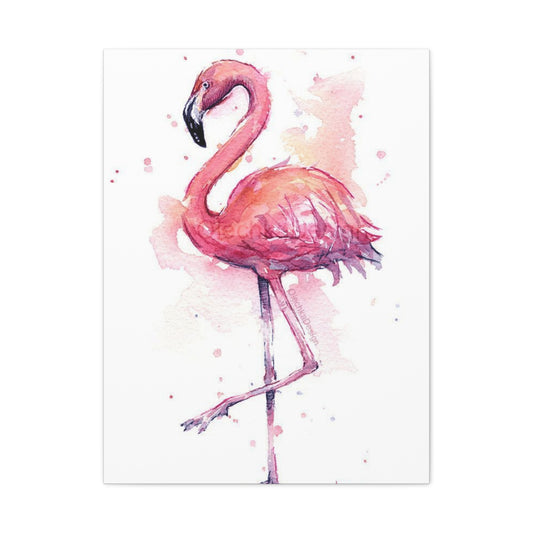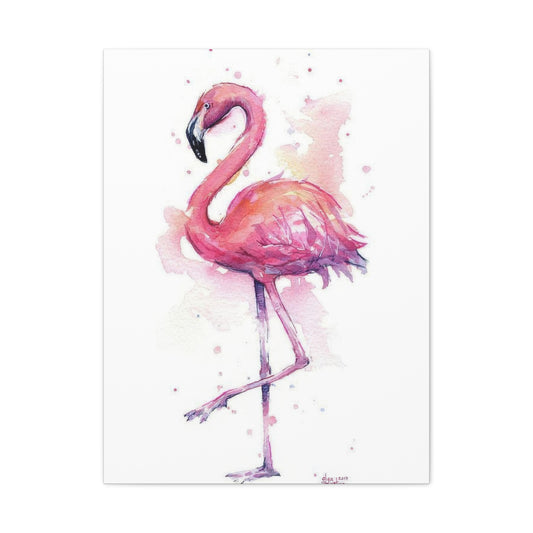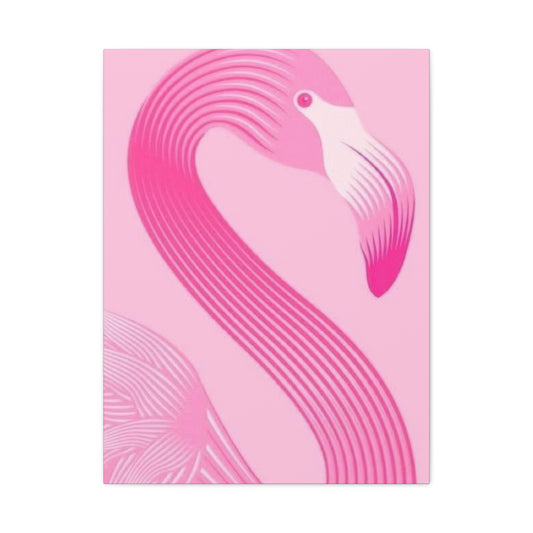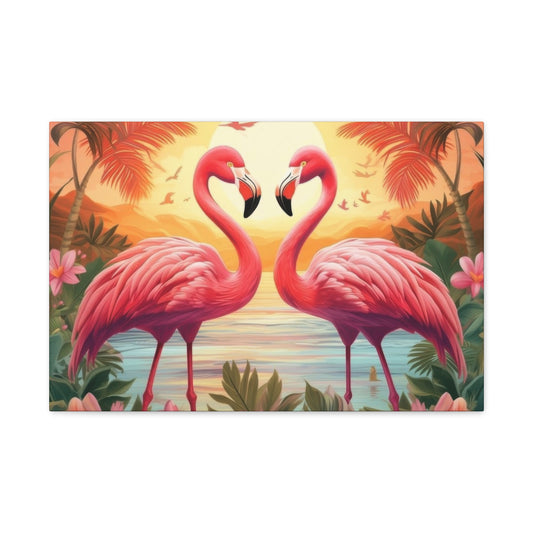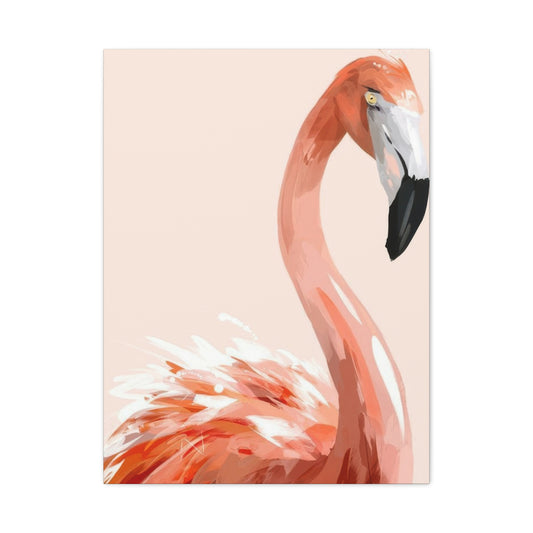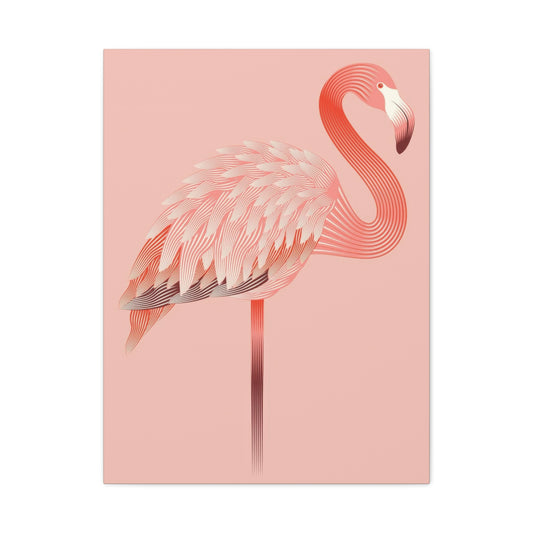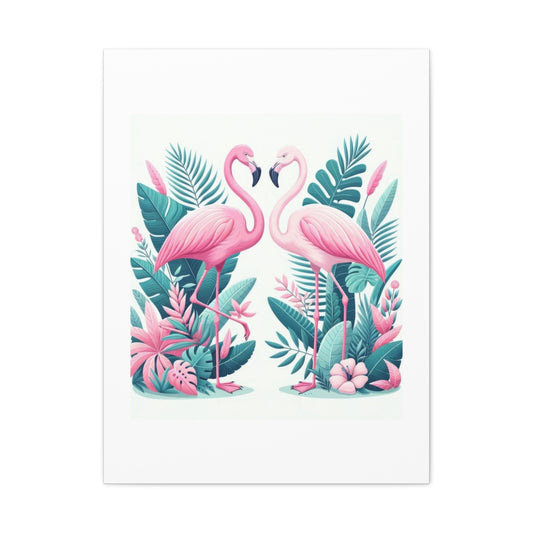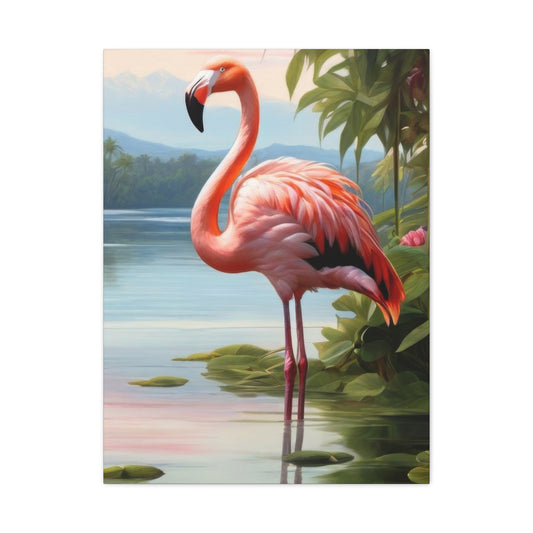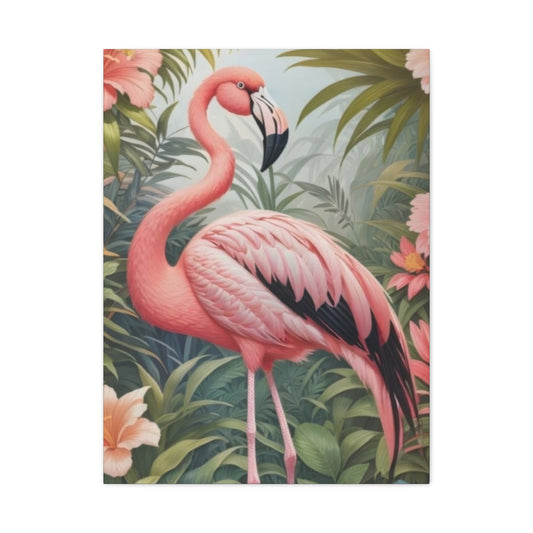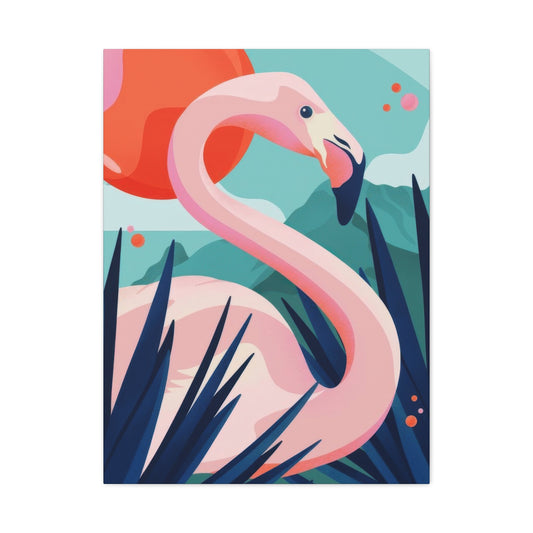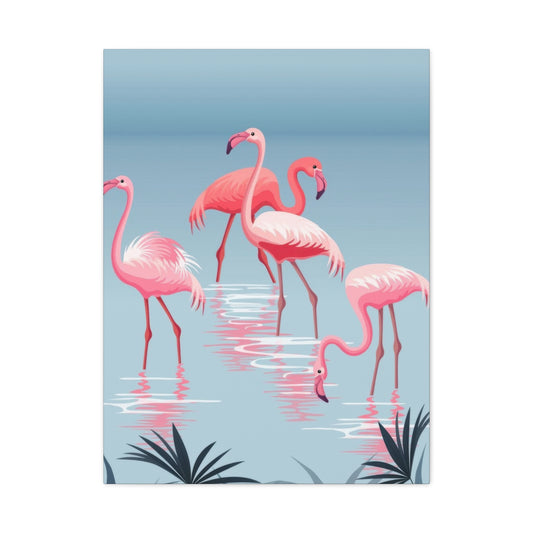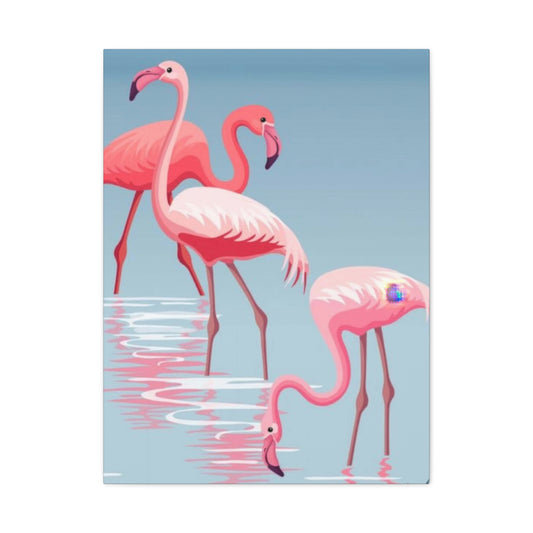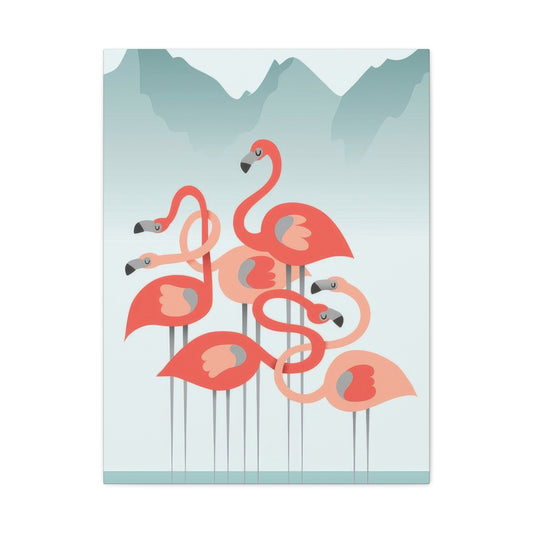Collection: Flamingo Wall Art
Guide to Flamingo Wall Art: Transform Your Space with Pink Paradise
Flamingo wall art has transcended mere decoration to become a powerful symbol of tropical elegance and sophisticated whimsy. These magnificent birds, with their distinctive pink plumage and graceful silhouettes, have captured human imagination for centuries. Ancient civilizations revered flamingos as symbols of balance, grace, and transformation, qualities that translate beautifully into contemporary home decor.
The journey of flamingo imagery from natural observation to artistic interpretation began in the early 20th century when travelers to tropical destinations brought back stories and sketches of these remarkable creatures. Artists quickly recognized the visual appeal of flamingo forms, incorporating them into various mediums including paintings, sculptures, and eventually wall decorations.
Modern flamingo wall art draws inspiration from multiple sources: the Art Deco movement of the 1920s, which celebrated geometric forms and exotic motifs; the mid-century modern aesthetic that embraced bold colors and natural themes; and contemporary minimalist approaches that focus on clean lines and subtle sophistication. This rich heritage makes flamingo wall art remarkably versatile, capable of complementing diverse interior design styles from traditional to ultra-modern.
The Historical Significance of Flamingo Imagery in Interior Design
The psychological impact of flamingo imagery cannot be understated. The color pink, predominant in flamingo art, evokes feelings of warmth, comfort, and optimism. Studies in color psychology reveal that pink hues can reduce stress levels and promote feelings of tranquility, making flamingo wall art an excellent choice for creating peaceful, inviting spaces.
Cultural anthropologists note that flamingo imagery often represents the desire to escape mundane reality and embrace a more exotic, carefree lifestyle. This symbolic meaning resonates particularly strongly in urban environments where residents seek to bring elements of natural beauty and tropical serenity into their daily lives.
The craftsmanship involved in creating quality flamingo wall art varies dramatically across different price points and artistic approaches. Hand-painted pieces often showcase individual brushstrokes and unique color variations that mass-produced items cannot replicate. Mixed-media works might incorporate feathers, metallic accents, or textured surfaces to create dimensional effects that enhance visual interest.
Contemporary artists continue to reinterpret flamingo imagery through various lenses, from hyper-realistic representations that capture every detail of flamingo anatomy to abstract interpretations that focus on essential forms and colors. This artistic diversity ensures that flamingo wall art remains fresh and relevant across changing design trends.
Exploring Different Artistic Styles and Mediums for Flamingo Wall Art
The realm of flamingo wall art encompasses an extraordinary range of artistic styles and mediums, each offering unique aesthetic qualities and practical considerations. Understanding these options enables informed decision-making when selecting pieces that will complement specific spaces and design objectives.
Realistic flamingo art aims to capture the authentic beauty of these birds with scientific accuracy and artistic skill. These pieces often feature detailed feather textures, accurate anatomical proportions, and naturalistic color palettes. Realistic flamingo art works exceptionally well in spaces that celebrate nature, such as sunrooms, botanical-themed bedrooms, or homes with extensive plant collections. The level of detail in realistic pieces makes them conversation starters and focal points that reward close examination.
Abstract flamingo art takes creative liberties with form, color, and composition to create emotionally resonant pieces that prioritize artistic expression over literal representation. These works might use bold color combinations, geometric shapes, or flowing lines to suggest flamingo forms while maintaining artistic freedom. Abstract pieces offer greater flexibility in matching existing color schemes and can complement both traditional and contemporary interiors.
Impressionistic flamingo art captures the essence and mood of these birds through loose brushwork, vibrant colors, and emphasis on light effects. This style evokes feelings of movement and spontaneity while maintaining recognizable flamingo characteristics. Impressionistic pieces work particularly well in casual, comfortable spaces where relaxation and creativity are priorities.
Mixed-media flamingo art incorporates multiple materials and techniques to create rich, textured surfaces that engage multiple senses. These pieces might combine traditional painting with collage elements, metallic accents, fabric textures, or three-dimensional components. Mixed-media works add depth and interest to spaces while demonstrating artistic innovation and craftsmanship.
Minimalist flamingo art distills flamingo imagery to essential elements, often using simple lines, limited color palettes, and clean compositions. These pieces appeal to contemporary sensibilities and work beautifully in modern interiors where simplicity and sophistication are valued. Minimalist flamingo art can provide subtle tropical touches without overwhelming existing design schemes.
Photography-based flamingo wall art captures real flamingo moments through skilled wildlife photography. These pieces offer authentic beauty and can transport viewers to exotic locations where flamingos naturally congregate. High-quality flamingo photography requires exceptional technical skill and often involves considerable travel and patience to capture perfect moments.
Digital art and graphic design approaches to flamingo imagery leverage technology to create precise, reproducible designs that can be customized for specific requirements. Digital flamingo art might incorporate typography, patterns, or graphic elements to create contemporary interpretations suitable for modern spaces. The precision possible with digital tools allows for exact color matching and sizing to meet specific design needs.
Color Psychology and Emotional Impact of Pink-Themed Artwork
The psychological effects of color in interior environments have been extensively studied, revealing that pink-dominant flamingo wall art can significantly influence mood, behavior, and overall well-being. Understanding these effects enables strategic use of flamingo art to create desired emotional responses and atmospheric qualities in different spaces.
Pink, the primary color associated with flamingos, exists in numerous variations from soft pastel tones to vibrant fuchsia shades. Each variation carries distinct psychological implications and practical applications. Soft pink tones promote feelings of calm, nurturing, and gentle energy, making them ideal for bedrooms, nurseries, or meditation spaces where relaxation is paramount.
Medium pink shades strike a balance between stimulation and tranquility, offering enough energy to maintain interest while providing emotional comfort. These tones work well in living rooms, dining areas, or home offices where both productivity and comfort are important considerations. The versatility of medium pink allows it to complement various color schemes without dominating the overall design.
Vibrant pink and fuchsia tones energize spaces and create bold focal points that command attention. These intense colors work best as accent elements rather than dominant themes, providing dramatic contrast and visual excitement. Bright pink flamingo art can invigorate exercise rooms, creative studios, or entertainment areas where high energy levels are desirable.
The interaction between pink flamingo art and other colors in the environment creates complex emotional responses that skilled interior designers leverage to achieve specific atmospheric goals. Pink paired with white creates fresh, clean impressions reminiscent of tropical beaches and clear skies. This combination works particularly well in bathrooms, kitchens, or coastal-themed spaces.
Pink combined with green evokes natural harmony and growth, reflecting the relationship between flamingos and their lush tropical habitats. This color pairing promotes feelings of balance and renewal, making it excellent for spa-like environments, bedrooms, or spaces dedicated to wellness and self-care.
The addition of gold or metallic accents to pink flamingo art introduces elements of luxury and sophistication while maintaining the warm, inviting qualities of pink. These combinations work beautifully in formal dining rooms, elegant bedrooms, or spaces where refined aesthetics are priorities.
Cultural associations with pink vary across different societies and generations, influencing how flamingo wall art is perceived and appreciated. Understanding these cultural nuances helps in selecting pieces that will resonate positively with intended audiences while avoiding potential negative associations.
The size and placement of pink-themed flamingo art also affects psychological impact. Large-scale pieces create immersive experiences that can transform entire rooms, while smaller pieces provide gentle color accents that enhance existing design schemes without overwhelming other elements.
Selecting Appropriate Sizes and Scales for Different Spaces
The relationship between flamingo wall art size and room proportions fundamentally determines visual impact and design success. Proper scaling ensures that artwork enhances rather than overwhelms or underwhelms the intended space, creating harmonious compositions that feel intentional and professional.
Small-scale flamingo art, typically measuring 8x10 inches to 16x20 inches, excels in intimate settings where subtle accents are preferred over bold statements. These pieces work beautifully in powder rooms, reading nooks, breakfast areas, or as components of larger gallery wall compositions. Small flamingo art allows for affordable experimentation with tropical themes while maintaining design flexibility.
The charm of small-scale pieces lies in their ability to add personality without commitment to major design changes. They can be easily relocated, regrouped, or replaced as tastes evolve or seasonal decorating preferences shift. Small flamingo art also enables the creation of curated collections that tell stories or explore variations on the flamingo theme.
Medium-scale flamingo art, ranging from 18x24 inches to 30x40 inches, provides substantial visual presence while remaining manageable in most residential spaces. These dimensions work well above furniture pieces such as sofas, beds, or dining room sideboards, where they can serve as focal points without overwhelming the surrounding area.
Medium-sized pieces offer excellent value propositions, delivering significant visual impact at moderate investment levels. They provide enough surface area for detailed artistic expression while remaining affordable for most decorating budgets. The versatility of medium-scale art makes it suitable for various room types and decorating styles.
Large-scale flamingo art, measuring 36x48 inches and beyond, creates dramatic focal points that can anchor entire room designs. These substantial pieces demand attention and work best in spacious areas with high ceilings and minimal competing visual elements. Large flamingo art can transform bland walls into stunning feature elements that define room character.
The investment in large-scale art requires careful consideration of long-term design plans, as these pieces significantly influence room aesthetics and are less easily changed than smaller alternatives. However, the impact of well-chosen large flamingo art can be transformative, creating memorable spaces that reflect sophisticated design sensibilities.
Multi-panel or diptych arrangements allow for flexible scaling while creating dynamic visual rhythms across wall surfaces. These configurations can be adjusted to fit specific wall dimensions while maintaining artistic coherence. Multi-panel flamingo art works particularly well in contemporary settings where clean lines and geometric arrangements are valued.
Ceiling height significantly influences appropriate art scale, with higher ceilings accommodating larger pieces more effectively than standard 8-foot heights. The relationship between horizontal and vertical proportions also affects visual balance, with wider walls often benefiting from horizontal compositions and narrow walls working better with vertical orientations.
Room-by-Room Placement Strategies for Maximum Visual Impact
Strategic placement of flamingo wall art requires understanding each room's function, traffic patterns, natural lighting conditions, and existing design elements. Thoughtful placement maximizes visual impact while ensuring that artwork enhances rather than conflicts with practical room usage.
Living room placement of flamingo art typically focuses on creating focal points that anchor seating arrangements and conversation areas. Above the sofa represents the most common placement strategy, where flamingo art can define the room's color palette and style direction. The standard guideline suggests hanging art 6-8 inches above furniture, though this can be adjusted based on ceiling height and personal preferences.
Corner arrangements in living rooms offer opportunities for unexpected visual interest, particularly when combined with accent lighting or decorative plants that echo tropical themes. Corner placement works especially well for multiple-piece arrangements or large-scale flamingo art that might overwhelm more central locations.
Bedroom flamingo art placement should prioritize calming effects and personal enjoyment since bedrooms are private retreats focused on rest and relaxation. Above the headboard remains the classic choice, creating a focal point that frames the bed while providing visual interest for anyone entering the room.
Alternative bedroom placements include opposite walls that can be viewed from the bed, creating pleasant visual experiences during quiet moments. Dressing areas and vanity spaces also benefit from flamingo art that enhances the getting-ready ritual with tropical elegance and positive energy.
Dining room flamingo art should complement the social nature of these spaces while withstanding the practical demands of food service and entertaining. Placement opposite the main seating area ensures that artwork remains visible throughout meals while avoiding potential damage from food service activities.
The scale of dining room flamingo art should match the formality level of the space and the size of the dining table. Intimate dining areas benefit from smaller, more personal pieces, while formal dining rooms can accommodate larger, more dramatic flamingo art that makes bold design statements.
Kitchen placement requires careful attention to moisture, heat, and grease exposure that could damage artwork over time. Flamingo art in kitchens works best in breakfast areas, butler's pantries, or other locations removed from direct cooking activities while still contributing to the overall design scheme.
Bathroom flamingo art must withstand high humidity levels while enhancing the spa-like qualities that many homeowners desire. Powder rooms offer ideal opportunities for bold flamingo art that creates memorable impressions for guests while requiring minimal maintenance concerns.
Hallway and transitional space placement allows flamingo art to create visual connections between rooms while providing interest in areas that might otherwise feel overlooked. These locations work well for series of smaller pieces or single statement works that guide traffic flow and maintain design continuity throughout the home.
Understanding Different Materials and Printing Methods
The materials and production methods used in flamingo wall art significantly impact durability, visual quality, cost, and appropriate placement within homes. Understanding these technical aspects enables informed purchasing decisions that align with specific needs, budgets, and aesthetic preferences.
Canvas printing remains the most popular medium for contemporary flamingo wall art, offering excellent color reproduction, texture appeal, and professional presentation. High-quality canvas prints utilize archival inks that resist fading and maintain color accuracy for decades when properly displayed away from direct sunlight. The fabric texture of canvas adds depth and interest that flat paper prints cannot match.
Gallery-wrapped canvas eliminates the need for additional framing while providing clean, contemporary presentation suitable for modern interiors. The stretching process requires skilled craftsmanship to prevent warping or sagging over time, making reputable suppliers essential for long-term satisfaction.
Paper-based flamingo prints offer affordability and versatility, particularly when professional framing is planned. High-quality art papers provide excellent detail reproduction and work well for limited budgets or temporary installations. However, paper prints require protective framing to prevent damage from moisture, handling, or environmental factors.
Photographic paper produces exceptional detail and color accuracy for flamingo photography, though it requires careful handling and professional framing for optimal presentation and protection. The glossy or matte finish options each provide distinct visual qualities that suit different aesthetic preferences and lighting conditions.
Metal printing represents a contemporary approach that infuses flamingo images directly into specially coated aluminum surfaces. The resulting prints exhibit vibrant colors, sharp details, and modern aesthetics that work particularly well in contemporary settings. Metal prints resist moisture and require minimal maintenance while providing unique visual qualities.
The durability of metal flamingo prints makes them suitable for high-traffic areas, bathrooms, or commercial installations where traditional materials might deteriorate. The mounting systems for metal prints often create floating effects that enhance modern presentation styles.
Acrylic mounting involves printing flamingo images on photographic paper and mounting them behind clear acrylic panels. This process creates depth, protects the image from environmental damage, and produces contemporary presentations with exceptional color saturation and clarity.
Wood-mounted flamingo prints combine rustic charm with artistic sophistication, particularly when the wood grain complements the natural themes inherent in flamingo imagery. Various wood species offer different colors and grain patterns that can enhance or contrast with the printed image.
Fabric printing enables the creation of flamingo wall hangings, tapestries, and textile art that add softness and warmth to interior spaces. High-quality fabric printing maintains color accuracy while providing unique textural qualities that paper and canvas cannot achieve.
The mounting and hanging hardware provided with flamingo wall art varies significantly in quality and ease of use. Professional-grade mounting systems ensure secure installation while minimizing wall damage and simplifying future adjustments or relocations.
Creating Cohesive Design Schemes with Flamingo Art Collections
Developing cohesive flamingo wall art collections requires strategic planning that balances visual variety with thematic unity. Successful collections create compelling narratives while maintaining aesthetic harmony across different pieces, sizes, and placement locations throughout the home.
Color coordination forms the foundation of effective flamingo art collections, though this does not require identical color schemes across all pieces. Instead, successful collections often utilize varying intensities of core colors, complementary accent tones, and neutral backgrounds that create visual relationships without monotony.
The concept of color temperature helps guide collection development, with warm pink tones creating cozy, intimate feelings and cooler coral or salmon shades providing more energetic, contemporary impressions. Mixing color temperatures within collections can create dynamic tension that maintains visual interest while preserving overall harmony.
Style consistency contributes to collection coherence, though perfect matching is neither necessary nor desirable. Collections might combine realistic flamingo portraits with abstract interpretations, provided they share common elements such as color families, compositional approaches, or artistic techniques that create unifying threads.
Successful collections often tell stories or explore themes that provide intellectual and emotional connections between individual pieces. These narratives might focus on flamingo behavior, tropical environments, seasonal changes, or abstract concepts such as grace, balance, or transformation that flamingos symbolize.
Scale relationships within collections require careful attention to prevent individual pieces from competing for attention or creating visual imbalances. The rule of odd numbers often applies, with collections of three, five, or seven pieces creating more dynamic arrangements than even-numbered groupings.
Varying sizes within collections creates visual rhythm and prevents the stagnation that can result from too much uniformity. Larger anchor pieces establish focal points while smaller works provide supporting detail and fill intermediate spaces in complex arrangements.
Framing consistency versus variety represents another important collection consideration. Matching frames create formal, gallery-like presentations that emphasize the artwork itself, while varied framing can add personality and prevent overly rigid appearances that might feel institutional.
The physical arrangement of flamingo art collections requires consideration of viewing distances, lighting conditions, and traffic patterns within each space. Collections work best when individual pieces can be appreciated both separately and as components of larger compositions.
Seasonal rotation capabilities allow collections to remain fresh and engaging over time. Storing some pieces while displaying others creates opportunities to rediscover favorites while preventing visual fatigue that can develop when the same arrangements remain unchanged for extended periods.
Budget considerations affect collection development strategies, with gradual acquisition often proving more satisfactory than rushed purchases that might result in compromises on quality or personal preferences. Starting with key anchor pieces and building collections over time allows for thoughtful selection and better integration with evolving design schemes.
Maximizing Natural and Artificial Lighting Effects
Lighting plays a crucial role in how flamingo wall art appears and impacts interior spaces. Understanding the interaction between different light sources and flamingo artwork enables strategic placement decisions that enhance color vibrancy, create dramatic effects, and maximize visual appeal throughout various times of day and seasons.
Natural lighting conditions change continuously throughout the day, affecting how flamingo art appears and feels within interior spaces. Morning light tends to be cooler and softer, which can mute the warm pink tones characteristic of flamingo imagery while creating gentle, peaceful impressions. Eastern-facing walls receive this soft morning light, making them ideal for subtle flamingo pieces that provide gentle awakening experiences.
Midday sunlight offers the most accurate color representation but can be harsh and potentially damaging to certain art materials. South-facing walls receive intense direct sunlight that can cause fading in lower-quality prints while making high-quality pieces appear exceptionally vibrant. UV-filtering window treatments help protect valuable flamingo art while maintaining beneficial natural illumination.
Afternoon and evening light tends toward warmer tones that complement and enhance the pink hues typical in flamingo art. Western-facing walls that receive this golden light can make flamingo artwork appear to glow with inner warmth, creating magical atmospheric effects during sunset hours.
Seasonal variations in natural light patterns affect flamingo art appearance throughout the year. Winter light tends to be cooler and less intense, potentially making flamingo art appear more subdued, while summer light enhances warmth and vibrancy. Understanding these patterns helps in selecting appropriate pieces for different orientations and adjusting artificial lighting to compensate for seasonal variations.
Artificial lighting systems provide consistent, controllable illumination that can dramatically enhance flamingo wall art presentation. Track lighting systems offer flexibility for highlighting individual pieces or creating dramatic accent effects that draw attention to specific collection elements.
LED technology provides energy-efficient lighting solutions with excellent color accuracy and minimal heat generation that protects artwork from damage. The ability to adjust LED color temperature allows fine-tuning of lighting effects to complement flamingo art throughout different times and activities.
Picture lighting, including traditional picture lights or modern LED strip systems, creates focused illumination that makes flamingo art appear gallery-quality while minimizing shadows and glare. Proper picture lighting requires careful attention to beam angles, color temperature, and intensity levels to achieve professional results.
Ambient lighting from ceiling fixtures, table lamps, or wall sconces creates overall room illumination that affects how flamingo art appears within the broader interior context. Warm ambient lighting enhances the cozy, tropical feelings associated with flamingo imagery, while cooler ambient light creates more contemporary, sophisticated impressions.
Layered lighting approaches combine multiple light sources to create complex, interesting illumination that can transform flamingo art appearance throughout different activities and times. These systems might include natural light, general ambient illumination, accent lighting for artwork, and task lighting for specific functions.
The placement of light sources relative to flamingo art requires consideration of reflection angles to prevent glare that can obscure detail or create viewing difficulties. Lights positioned at 30-degree angles from perpendicular typically minimize problematic reflections while providing effective illumination.
Color-changing LED systems enable dynamic lighting effects that can emphasize different aspects of flamingo art or create seasonal variations without relocating artwork. These systems work particularly well with multi-colored flamingo pieces that contain various hues that can be selectively emphasized through lighting choices.
Complementary Color Palettes and Coordinating Decor Elements
Creating harmonious interior environments with flamingo wall art requires understanding color theory principles and applying them strategically throughout furnishings, accessories, and architectural elements. Successful color coordination enhances the impact of flamingo artwork while creating cohesive, professionally designed spaces.
The primary pink tones in flamingo art serve as starting points for developing comprehensive color schemes that extend throughout entire rooms or homes. Monochromatic approaches utilize various shades, tints, and tones of pink to create sophisticated, unified appearances that feel intentional and refined. These schemes work particularly well in bedrooms, bathrooms, or other intimate spaces where tranquility is paramount.
Complementary color relationships pair pink flamingo art with green accents to create vibrant, energetic schemes that reflect natural tropical environments. Various shades of green, from sage and mint to emerald and forest green, offer different personality expressions while maintaining the fundamental complementary relationship that creates visual excitement.
Plant materials provide natural green accents that complement flamingo art while reinforcing tropical themes and improving indoor air quality. Large floor plants like fiddle leaf figs or monstera create dramatic focal points, while smaller plants such as pothos or philodendron provide subtle green touches throughout the space.
Analogous color schemes combine pink flamingo art with neighboring colors such as coral, peach, orange, or lavender to create smooth, flowing color transitions that feel natural and comfortable. These approaches work well for creating gradient effects or emphasizing specific mood qualities associated with different color combinations.
Triadic color relationships incorporate pink flamingo art with blue and yellow accents to create bold, dynamic schemes that feel contemporary and energetic. The key to successful triadic schemes lies in balancing the intensity and distribution of each color to prevent any single hue from overwhelming the composition.
Neutral backgrounds provide versatile foundations for flamingo art while allowing the artwork to serve as primary color sources. White, cream, beige, and gray backgrounds each create different impressions while maintaining focus on the flamingo imagery. Cool grays create contemporary, sophisticated settings, while warm creams and beiges provide cozy, traditional atmospheres.
Metallic accents in gold, rose gold, or copper harmonize beautifully with pink flamingo tones while adding luxury and sophistication to overall design schemes. These metallics can be incorporated through picture frames, light fixtures, decorative accessories, or furniture hardware to create cohesive, upscale appearances.
Textile selection plays a crucial role in extending flamingo art color themes throughout interior spaces. Throw pillows, curtains, rugs, and upholstery fabrics provide opportunities to echo, complement, or contrast with flamingo art colors while adding texture and comfort to rooms.
Pattern mixing with flamingo art requires careful attention to scale, color, and style relationships to prevent visual chaos. Successful combinations might include geometric patterns in complementary colors, botanical prints that reinforce natural themes, or abstract designs that echo the fluid lines found in flamingo silhouettes.
The finish and texture of surfaces throughout rooms affect how flamingo art colors appear and interact with other design elements. Glossy surfaces reflect light and intensify colors, while matte finishes absorb light and create more subdued, sophisticated impressions.
Seasonal decorating approaches can incorporate flamingo art into temporary color schemes that change throughout the year. Summer schemes might emphasize bright, energetic colors that celebrate the tropical nature of flamingo imagery, while winter approaches could focus on softer, more muted tones that provide warmth and comfort during colder months.
Furniture Arrangement and Spatial Relationships
The relationship between flamingo wall art and furniture placement significantly impacts both the aesthetic success of interior designs and the functional efficiency of living spaces. Strategic furniture arrangement can enhance artwork visibility, create conversation areas that showcase collections, and establish visual balance throughout rooms.
Sofa positioning relative to flamingo wall art determines primary viewing angles and influences how artwork integrates with daily living activities. Traditional arrangements place seating to face featured artwork, creating natural focal points that anchor conversation areas while providing continuous visual enjoyment for occupants and guests.
Alternative furniture arrangements might position seating at angles to artwork, creating dynamic viewing experiences that reveal different aspects of flamingo pieces as people move through spaces. These arrangements work particularly well with three-dimensional or heavily textured artwork that rewards examination from multiple perspectives.
The height relationship between seating and wall-mounted flamingo art affects viewing comfort and visual integration. Standard guidelines suggest that artwork centers should align with average eye levels when seated, typically 54-60 inches from floor level, though these recommendations can be adjusted based on specific furniture heights and personal preferences.
Coffee table and accent table placement provides opportunities to echo flamingo art themes through decorative accessories, books, or plants that reinforce tropical aesthetics. These horizontal surfaces serve as staging areas for items that support and extend the color schemes, themes, or moods established by wall-mounted artwork.
Dining room furniture arrangements with flamingo art require consideration of both seated and standing viewing positions. Artwork placed to be visible from dining chairs during meals should be positioned appropriately for seated viewing, while pieces intended for appreciation during social circulation can be placed higher to accommodate standing positions.
Bedroom furniture relationships with flamingo art typically prioritize views from the bed itself, though placement should also consider appearances from doorways and dressing areas. Multiple viewing angles in bedrooms allow artwork to be appreciated during various activities from rest to getting ready for daily activities.
Storage furniture such as bookcases, armoires, or entertainment centers can serve as platforms for displaying smaller flamingo art pieces or complementary decorative objects that extend artistic themes throughout rooms. These arrangements create layered visual experiences that reward closer examination while maintaining overall design coherence.
The scale relationships between furniture and flamingo art must be carefully balanced to prevent either element from overwhelming the other. Large furniture pieces can accommodate substantial artwork that might overwhelm smaller furnishings, while delicate furniture benefits from proportionally scaled art that maintains visual harmony.
Traffic flow patterns through rooms affect both furniture placement and artwork positioning. Flamingo art should be visible from primary circulation routes without impeding movement or creating bottlenecks that disrupt functional room usage. Strategic placement can actually guide traffic flow while providing visual interest along circulation paths.
Flexible furniture arrangements that can be reconfigured for different activities or occasions require flamingo art placement that works effectively with multiple layout options. This consideration is particularly important in multipurpose rooms or spaces that regularly host gatherings of varying sizes and formats.
The relationship between window treatments and furniture placement affects natural light patterns that influence flamingo art appearance throughout the day. Furniture positioning should consider how changing light conditions will affect artwork visibility and color appearance to optimize visual impact during primary usage periods.
Working with Different Architectural Styles and Features
Flamingo wall art can enhance and complement various architectural styles when selected and positioned thoughtfully to work with existing structural elements, proportions, and aesthetic traditions. Understanding how to adapt flamingo imagery to different architectural contexts ensures successful integration that feels natural and intentional.
Traditional architecture with formal proportions, classical details, and established decorating conventions can successfully incorporate flamingo art through careful selection of pieces that respect historical precedents while adding contemporary personality. Realistic flamingo paintings in traditional frames work particularly well in colonial, Victorian, or other period-inspired interiors where naturalistic artwork has historical precedent.
The key to integrating flamingo art in traditional settings lies in respecting established color palettes, maintaining appropriate formality levels, and selecting pieces that enhance rather than conflict with architectural details such as crown molding, wainscoting, or built-in millwork.
Contemporary architecture with clean lines, open floor plans, and minimalist aesthetics provides excellent frameworks for modern flamingo art interpretations. Abstract or stylized flamingo pieces that emphasize form and color over realistic detail complement contemporary design principles while adding organic softness to sometimes stark architectural environments.
Mid-century modern architecture, with its emphasis on natural materials, horizontal lines, and connection to outdoor environments, provides ideal settings for flamingo art that celebrates tropical themes and organic forms. The period's embrace of bold colors and artistic expression aligns perfectly with vibrant flamingo imagery.
Mediterranean and Spanish Colonial architectural styles, characterized by warm colors, textured surfaces, and outdoor living emphasis, create natural settings for flamingo art that echoes the tropical and exotic themes inherent in these design traditions. Warm pink flamingo tones harmonize beautifully with terracotta, ochre, and cream color palettes typical of these styles.
Craftsman and Arts and Crafts architecture, with emphasis on handcrafted details and natural materials, can incorporate flamingo art that celebrates artisanal techniques and organic themes. Hand-painted or mixed-media flamingo pieces that show evidence of artistic process align well with the movement's values while adding color and personality to typically earth-toned interiors.
Industrial architectural elements such as exposed brick, steel beams, or concrete surfaces provide interesting contrasts for flamingo art that can soften harsh textures while adding warmth and personality to utilitarian spaces. The juxtaposition of delicate flamingo imagery against rough industrial surfaces creates dynamic visual tension that feels contemporary and sophisticated.
Coastal and nautical architectural themes naturally accommodate flamingo art that reinforces connections to water, beaches, and tropical environments. The challenge lies in avoiding cliched combinations while creating fresh interpretations that feel sophisticated rather than kitschy or overly themed.
High-ceiling spaces in various architectural styles provide opportunities for large-scale flamingo art that can command appropriate attention and create dramatic focal points. The vertical emphasis possible in these spaces allows for ambitious artwork that might overwhelm standard ceiling heights.
Built-in architectural features such as niches, alcoves, or display shelves can showcase smaller flamingo art pieces or collections in ways that feel integrated with the architectural design rather than applied as afterthoughts. These features provide natural framing and emphasis that enhances artwork impact.
Historical architectural details such as decorative moldings, ceiling medallions, or period hardware should be considered when selecting flamingo art frames and mounting systems to ensure visual compatibility and appropriate respect for architectural integrity.
The orientation and proportion of rooms within different architectural styles affect appropriate flamingo art selection and placement strategies. Long, narrow rooms typical of shotgun or railroad-style houses require different approaches than square rooms or open-plan spaces found in contemporary designs.
Seasonal Decorating and Rotating Displays
Incorporating flamingo wall art into seasonal decorating schemes creates opportunities for maintaining visual interest throughout the year while adapting interior environments to reflect changing seasons, holidays, and personal preferences. Strategic seasonal approaches prevent decorative stagnation while maximizing artwork investment value.
Spring seasonal decorating with flamingo art emphasizes renewal, growth, and fresh beginnings that align naturally with flamingo symbolism of transformation and grace. Lighter, more delicate flamingo pieces work well during spring months, particularly when combined with fresh flowers, new plant growth, and cleaning or refreshing activities that characterize the season.
Pastel color schemes that incorporate soft pink flamingo tones blend beautifully with spring's traditional palette of light greens, buttery yellows, and sky blues. These combinations create fresh, optimistic atmospheres that celebrate the end of winter and anticipation of warmer weather ahead.
Summer decorating approaches can embrace the full tropical potential of flamingo art through bold colors, exotic accessories, and emphasis on outdoor living connections. Vibrant flamingo pieces work particularly well during summer months when high natural light levels can support more intense colors and dramatic presentations.
Coastal summer themes that incorporate flamingo art alongside seashells, driftwood, and nautical accessories create sophisticated tropical environments that feel like vacation destinations. The challenge lies in achieving elegance while avoiding overwhelming or kitschy combinations that might diminish the artwork's impact.
Fall seasonal transitions can incorporate flamingo art into warmer, more subdued color schemes that reflect changing foliage and preparation for cozier indoor living. Coral and salmon-toned flamingo pieces work particularly well with autumn's rich oranges, deep reds, and golden yellows while maintaining tropical warmth as temperatures cool.
Winter approaches to flamingo art focus on providing warmth, color, and reminders of warmer climates during cold, dark months. Bright flamingo pieces can serve as antidotes to seasonal depression while maintaining visual interest when outdoor environments become monochromatic and less inspiring.
Holiday decorating that incorporates flamingo art requires thoughtful integration that enhances rather than conflicts with traditional seasonal themes. Pink flamingo tones can complement Valentine's Day decorations while maintaining year-round appeal, and tropical themes can provide unique alternatives to traditional Christmas decorating for those seeking non-traditional holiday approaches.
Rotation strategies for flamingo art collections prevent visual fatigue while maximizing investment value through varied displays throughout the year. Storage solutions that protect artwork during rotation periods ensure long-term preservation while enabling flexible decorating approaches that maintain freshness and interest.
Display rotation can follow formal seasonal schedules or respond to mood changes, special events, or evolving personal preferences. The key lies in maintaining some consistency to preserve overall design coherence while allowing enough change to create renewed interest and discovery opportunities.
Documentation of successful seasonal arrangements through photographs enables replication of particularly effective combinations while providing inspiration for future variations. This documentation becomes increasingly valuable as collections grow and rotation possibilities multiply over time.
Climate considerations affect both seasonal decorating approaches and artwork preservation requirements. Regions with extreme seasonal variations may require different strategies than temperate areas with more stable conditions throughout the year.
Conclusion
Creating stunning gallery walls with flamingo art requires understanding composition principles, spatial relationships, and visual balance techniques that transform individual pieces into cohesive, dynamic displays. Successful gallery walls become architectural features that define spaces while showcasing artwork collections effectively.
Planning gallery wall layouts begins with understanding available wall space and establishing overall composition boundaries that will contain the arrangement without appearing cramped or sparse. Paper templates cut to match artwork dimensions enable experimentation with various arrangements before committing to nail holes or mounting hardware.
The concept of visual weight helps guide gallery wall composition by balancing darker, larger, or more complex pieces with lighter, smaller, or simpler elements to create stable, pleasing arrangements. Visual weight is not necessarily related to physical weight, as bright colors or busy patterns can carry significant visual impact despite modest dimensions.
Symmetrical gallery wall arrangements create formal, balanced presentations that work well in traditional settings or spaces where order and predictability are valued. These layouts typically feature central focal points with balanced supporting elements arranged in mirror-image patterns that feel stable and intentional.
Asymmetrical arrangements offer more dynamic, contemporary presentations that can feel more organic and interesting while requiring greater skill to achieve visual balance without appearing chaotic or accidental. These layouts work particularly well with varied flamingo art sizes and styles that resist rigid organization.


